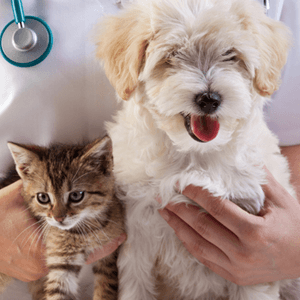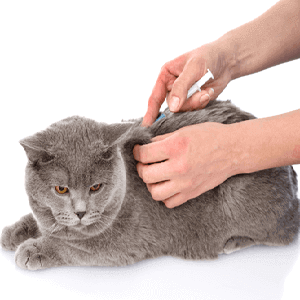Why do we vaccinate our pets?
Vaccinations for Pets
You can look only to history to understand the importance of vaccinations in preventing life threatening illnesses. In fact, vaccination along with clean drinking water and proper personal hygiene are affordable life improvements that have been credited with saving millions of lives over the years. Vaccines have worked so well that in certain parts of the world some deadly diseases have been eradicated. These life saving benefits, once reserved only for humans, have been extended to animals including companion animals such as dogs and cats. They are an important tool used to keep your pets healthy and safe by increasing their immune-system's ability to fight-off deadly pathogens (mainly viruses). This is a preventative approach to medicine that also reduces the likelihood of an unexpected and more expensive urgent care visit to the veterinarian if your pet becomes suddenly ill from an otherwise preventable disease.
Vaccinations in Dogs Only:
Canine Bordetella (Kennel Cough)
Bordetella is a highly contagious upper respiratory disease caused by an airborne bacterial infection. The disease is transmitted among dogs and may be contracted while at the groomer, pet boarding, dog park, doggie daycare, playing with a neighbor's dog, pet sitter, dog walking, and pretty much any direct and indirect contact with other sick dogs. A contagious dog may not show signs of illness until later stages of the disease. As the name suggests, symptoms of kennel cough includes: coughing, lethargy, sneezing, runny nose, and in worse case lead to severe pneumonia.
Distemper/Adenovirus 2 /Parvovirus
- For short, DA2P is a three in one vaccination that boosts your dogs immune system or build up antibodies in response to these three viral diseases.
Distemper
- This virus is part of the measles family and affects a wide variety of animals including dogs, ferrets, raccoons, bears and civets. This means that contact with wildlife can also put your pet at risk. Puppies are particularly at risk. It is usually spread though nasal and oral secretions. The virus tends to attack the respiratory system but can also manifests itself via the nervous system. The major signs include nasal and ocular discharge, conjunctivitis, pneumonia, fever and diarrhea. Another classic sign can include hardening of the footpads (called hyper keratosis). When the virus attacks the nervous system, this can lead to seizures and myoclonus (repetitive motions with the jaw or head also called chewing gum seizures). There is no cure for distemper and treatment is only supportive. The prognosis is usually very guarded and most puppies do not survive. Those that do survive can have long lasting effects from the infection (such as lifelong seizures) so it is best to prevent the disease by administering vaccination.
Canine Adenovirus (Type 1 & 2)
- Also known as infectious canine hepatitis, CAV-1 attacks the liver causing severe liver damage and can lead to liver failure. Most patients will start off with a fever, loss of appetite, depression, vomiting, diarrhea, and abdominal pain. CAV-2 is mainly associated with upper respiratory disease and usually leads to self limiting upper respiratory infections. Vaccination with CAV2 cross protects against both CAV 1 and 2. Vaccination with CAV 1 vaccine is not recommended due potential reactions.
Parvovirus
- Puppies in particular are very susceptible to Parvovirus. It is spread through contact with infected fecal material. The virus attacks the gastrointestinal tract and the bone marrow causing extensive damage. This leads to severe, bloody diarrhea, vomiting, and depletion of the immune cells in the bone marrow. This puts the puppy at risk for life threatening dehydration and infection. Although this illness can be difficult to recover from once a dog has succumbed to it, with supportive care some survival rates can approach 80%. Symptoms of Parvo include vomiting, bloody and foul smelling, possibly bloody diarrhea, lethargy, fever, and abdominal pain.
Vaccinations in Cats Only:
Feline Leukemia Virus (FeLV)
- this disease affects cats and is transmitted by body fluids including saliva and nasal secretions. The virus can also be transmitted from mother to kitten or through bite wounds from an infected cat. Some infected cats are able to eliminate the virus and become immune while others eventually succumb to the disease. The virus will invade different tissues of the body including the bone marrow where it may induce cancer, more specifically known as leukemia. It is immunosuppressive and thus may indirectly cause other illnesses due to secondary infections. A large percentage of the cats that are exposed to this virus will have latent (hidden) infections and will be capable of transmitting the disease in saliva, tears, and urine. Some of these latent carriers will become clinically ill when stressed. Kittens are most susceptible to Feline Leukemia and it is recommended that all kittens be vaccinated against feline leukemia in their first year of life.
Feline AIDS (FIV)
- This disease is similar to the human virus HIV/AIDS in that it compromises the cats immune system but can only infect cats. The disease is spread through bite wounds and can also be transmitted from mother to kitten. This virus can initially infect the cat and then remain latent in the body over several years. Eventually, it will lead to immunosuppressant and leave the cat susceptible to chronic illnesses and even cancer. There is currently no vaccination that is recommended at this time. The only way to prevent Feline Aids is to keep your cats indoors where they would avoid contact with infected and possibly feral cats.
Vaccinations for Both Dogs & Cats:
Canine Rabies and Feline Rabies Vaccination
- Many wild life animals such as bats, raccoons, coyote, and foxes are potential carriers of the Rabies virus. Your pet could easily come in contact with Rabies. Signs of this disease include foaming at the mouth and a rabid demented demeanor in which they indiscriminately attack other animals or people, even their owners. The rabies disease is communicable to both animals and people. The disease is fatal in people. There are no treatments for dogs that have rabies. Pets with signs of rabies (suspected rabies) are euthanized and their remains are tested for the presence of the virus.


